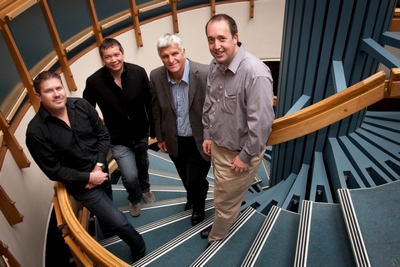Canada's Bio-Pathways

Pictured from right to left: Andrew Goodison with Warren Parker, Michael Jack and Trevor Stuthridge from Scion. Andrew’s visit was sponsored by New Zealand Trade and Enterprise.
Canada might be a hemisphere away from New Zealand, but their forest products industry is not that far removed. It is an export-focused sector dominated by traditional manufacturers of pulp, paper and board products struggling to return a profit. Like us, Canadian foresters are under pressure to innovate and compete on the global market. For them, the pathway forward is clear.
A project undertaken by the Canadian forestry sector, known as Bio-Pathways, could give New Zealand manufacturers some clues about future options. A key figure in the project, Andrew Goodison of FPInnovations in Canada, recently visited New Zealand to address the Advanced Biofuels Research Network symposium hosted in Wellington by Scion.
Andrew says the Bio-Pathways project took a hard look at future options for Canadian manufacturers to produce a wide range of bio-products from wood fibre. The results showed that strong markets will continue to exist for traditional forest products such as wood and pulp. Meanwhile, new technologies with smaller niche markets will generate a much higher price.
“It’s all about getting the highest dollar value out of every cubic metre we cut,” he says. “Numerous viable options exist to convert forest biomass to bio-energy, bio-chemicals and bio-materials. These options are best achieved by integrating their production with the traditional forest industry.”
By combining the old and the new, projections show that companies will experience growth rates far above those being generated by the traditional forest product sector. According to the Bio-Pathways report, rapidly growing markets for new bio-products based on wood fibre could reach an estimated $200 billion by 2015.
“The potential market sizes are staggering. Countries and companies with the right policy framework, the desire to foster innovation and the ability to deploy the resulting technology will be poised to grab market share in these areas.”
While the Bio-Pathways project identified a clear opportunity for the Canadian forest industry, how will they bring their vision to reality?
It is already happening. Sawmills are expanding into bioenergy and pulp mills are converting into bio-refineries for production of pulp, bio-energy and bio-chemicals. But what does it take to initiate change on this scale?
“The Government has a huge role to play in helping to de-risk investments in new technology and foster innovation across the value chain. The industry has united to present a single voice to government and results from this study provide quality information that is being used to inform policymakers,” Andrew explains. “The other crucial factors are to embrace new technologies and partner with the right companies to accelerate commercial success.”
Following Andrew’s visit, Scion is now assisting with the application of the Bio-Pathways methology to the New Zealand forest industry.
For more information and to access the
Bio-Pathways report see www.fpinnovations.ca or www.fpac.ca.
< Last Article | Contents | Next Article >
